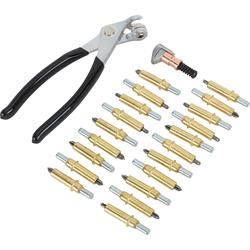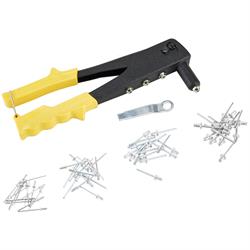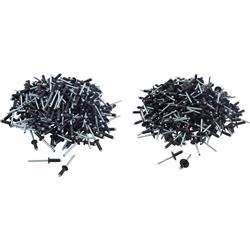Types of Rivets and How to Use Them
A “Riveting” Solution to a Blind Mounting Hole Problem
Rivets are hardly a new way to assemble two items, their usage dates back several hundreds of years. Rivets became a popular way to construct ships, bridges, and more starting in the mid-19th century. Famous works like the Eiffel Tower, Golden Gate Bridge, and even the RMS Titanic, were all constructed with rivets. These rivets were of a solid design and depending upon their size were either cold riveted or hot riveted, where the rivet was heated to a cherry red and then hammered to form the rivet head and secure the two work pieces together. Very early aviation construction used solid rivets as well. However, that all changed in the early 20th century.
The year was 1934, and the fledgling aviation industry was looking for a way to assemble planes with fasteners that the assembly line could not easily access the back side of like in a traditional solid rivet configuration where one person drove the rivet and a second person held the bucking bar on the back side of the rivet. The George Tucker Eyelet Company, which made shoelace eyelets for shoes and boots, was approached to design this “blind” fastening system that could be secured from one side of the work piece and brought forth the POP® rivet. So named for the “popping” sound it makes when securing the two work pieces together. Today, the company is a part of Stanley Engineered Fastening (itself a part of Stanley Black & Decker) and the brand name POP® rivet has become a universal descriptor for blind rivets, much like “Kleenex” for tissues or “Xerox” for copying has over the years. Blind rivets are often simply, yet incorrectly, referred to as a pop rivet.
Are Rivets a Better Choice Than Bolts or Screws?
So why use a rivet over a typical nut and bolt or even a tapping screw? For starters, tapping screws rely on the threads and the underside of the screw head for retention and can back out due to vibration; not cool at all for your race car let alone a street car. Nuts and bolts work great, if you have access to the back side of the work area and locking fasteners eliminate the worry of loosening, but all those nuts and bolts tend to add a lot of weight. This is where a rivet becomes the preferred method of retention. They retain two or more components together easily, do not require access to the back side of the work piece, and will not come loose if they are installed properly. Using rivets in your build saves weight and provides tight panel fitment. Today, rivets are used not only in OEM vehicle manufacturing, but in race car interior and exterior panels, and more. If you’re planning an aluminum interior conversion, rear seat delete in your muscle car, firewall bulkhead panel, or other such steel or aluminum work in your project car then rivets will be needed, but which ones and what sizes? Read on.
What Types of Rivets Are There, and Which Should I Use?
The two main categories of rivet styles are solid, or aviation rivets, and blind rivets. Within these two main categories you will find different rivet styles based upon head design, how they grip the work materials, and other such descriptors. As mentioned previously, solid rivets require access to the backside of the work piece, while blind rivets do not. This is the first step in determining the proper rivet for the project. Even when solid rivets can be used it may make more sense to use a blind rivet, as solid rivets require special tools to properly seat and form the rivet head to secure the workpieces together. We will say though, there is nothing like the look of solid rivets if you’re going for style points. That said, for the average race car panel installation or hot rod aluminum interior build, blind rivets get our vote all day long, but let’s delve a little deeper into each style so you can make your own decision.
Solid Rivets
Solid, or aviation, rivets are available in aluminum, as well as steel and even brass, and require access to the back of the workpiece, as we’ve previously noted. This is because a solid rivet obtains its retention by being driven by a rivet setting mandrel (usually mounted in an air chisel/hammer) against the “factory” head, while the back side of the rivet, known as the “shop” head, is formed from the blows from the mandrel into a bucking bar. The bucking bar is available in numerous sizes, lengths, and offsets to allow reaching the open end of the solid rivet. In general, if you have large access to the back of your workpiece you can set solid rivets with a basic body hammer and dolly kit. It’ll get the job done but might be a bit tedious if you have a lot of rivets to set.
With solid rivets the proper rivet length is more critical than with a blind rivet. For proper workpiece retention and rivet head deformation/sizing the rivet body should extend through the workpieces 1.5 times the diameter of the rivet. For example, a 3/16-inch rivet should have approximately .281 inches of body, or shank exposed before being set. Once the rivet has been set the shop head should be 1.5 times the rivet’s body diameter and.5 times the rivet diameter in thickness. Obviously, these dimensions are critical in aviation, but if you’re simply using solid rivets to mount a fan shroud or interior trim bits, these specs aren’t as critical. Solid rivets aren’t really used much in automotive assembly, and short of our DIY aluminum bomber seats, Speedway Motors does not currently carry solid rivets or the tools to install them.
Blind Rivets
Blind rivets are, for the most part, what are commonly used in automotive applications. Blind rivets are easily set with one person, greatly reducing installation time, while maintaining the strength of screws, bolts, or even welding, when used in the proper quantity/spacing. Blind rivets are designed as a two-part component with the rivet body and an internal mandrel in the center. Blind rivets are commonly made from aluminum and steel, but you will also find stainless steel and even plastic composites. The mandrel isn’t always the same material either. For example, you will find aluminum pop rivets with a steel mandrel, which increases clamp loads since the steel mandrel takes more force before it separates from the rivet body. Like the solid rivet, the blind rivet has a work specification for workpiece thickness, however, the blind rivet is a little more forgiving to grip range and often a rivet that is just a bit too long will still set cleanly. If you really want to take a deep dive into blind rivets the International Organization of Standards (ISO) white paper on blind rivet terminology and definitions is a good read.
Speedway rivet sizes and grip ranges:
- 1/8” Tru-Rivets: 3/16” to 1/4” grip range
- 3/16” Tru-Rivets: 1/4” to 3/8” grip range
- 1/8” Multi-Grip: 1/32” to 3/16” grip range
- 3/16” Multi-Grip: 1/8” to 3/8” grip range
- 3/16” Exploding: 0 to 3/8” grip range
For 3/16-inch Tru-Rivets and Multi-Grip rivets we offer rivet backing washers (shown here) to provide more support on thinner materials or to help with worn or out of round rivet holes.
Speedway Motors offers three of the most used automotive blind rivets for your race car, muscle car, hot rod, or classic pickup project. These include the open end (Tru-Rivets), multi-grip, and exploding style rivets. We have provided additional detail on each style of blind rivet below.
Open end (Tru-Rivets)
- The most common or “standard” type of blind rivet
- Has a narrow window of grip range
- When set the back side of the rivet will have a slight bulge holding it in place
- Rivet back-up washers are suggested when fastening soft materials or when the hole is oversized
Multi-Grip
- Wide window of grip range
- When set the back side will have a large bulge to hold it in place
- Works in worn, oblong, or oversized holes
- Rivet back-up washers are suggested when fastening soft materials
Exploding
- Wide window of grip range
- When set the back of the rivet splits into three large flanges to hold it in place
- Works in worn, oblong, or oversized holes
- Rivet back-up washers are not necessary
- Lower clamping force than open end or multi-grip rivets
How Do Rivets Work and How Are They Installed?
Installing a blind or “pop rivet” is accomplished using either a hand riveting tool, AKA a rivet gun or a pneumatic air riveter. The air riveter is much easier on the hands if you’re planning several hundred rivets to be installed. An interesting installation tool we also offer is the RiveDrill blind rivet gun drill attachment which uses your 3/8 drill (cordless, corded, or air powered) to install blind rivets. Whatever pop rivet tool option you choose the tool is designed to grab the blind rivet’s mandrel and pull it through/out of the rivet. This force deforms the end of the rivet, securing the workpieces together, and then the mandrel shears, separating it from the rivet body. Shown here is an exploding rivet after the mandrel has been pulled through to shearing.
What Additional Tools Will Help with Rivet Installation
While the various rivet guns mentioned above are critical to properly seating a blind rivet and removing the mandrel, there are several other great tools that aid in rivet installation you may wish to consider adding to your tool collection besides the rivet gun, starting with our double ended drill bits. These drill bits are perfect for drilling 3/16-inch holes in your chassis, metal body panels, and more for 3/16-inch rivet installation. They allow you to easily flip the drill bit in your drill chuck and keep on working if your bit gets too dull or you break a bit.
Another great tool is our Cleco tool and fastener kit. Our Cleco tool kit allows you to temporarily secure your workpieces together as you drill holes for rivet installation. Simply drill a few starter holes, install the Cleco clamps, and now your workpieces will stay in perfect alignment as you continue to add rivet holes.
If you’re just adding a couple of rivets to secure a small bracket it’s easy to get everything lined up and looking good with a measuring tape and a grease pencil or marker. But what about a larger panel with a dozen or more rivets? To maintain accurate rivet spacing on a straight line to ensure the finished work not only looks great, but to ensure your rivets are properly securing your workpieces, you need to use a rivet fan spacing tool. We offer a 10-hole rivet fan spacer and a 20-hole rivet fan spacer that allow you to easily set rivet spacing dimensions on your workpiece. Secure one end with the above mentioned Cleco tool and clamp, set your rivet spacing, and mark the remaining holes to be drilled.
As you can see by our guide’s information, using rivets in place of other fasteners is a great way to secure body panels, interior sheetmetal, brackets, and more in a semi-permanent fashion without the weight of nuts and bolts or the expense of welding equipment and the skill required to weld. Riveting will easily allow dissimilar metals to be secured together, such as an aluminum panel on a steel frame, something that cannot be accomplished with welding. Determine your workpiece thickness and the proper rivets you need to complete the job, order the necessary tools, and get to “popping” some rivets!











